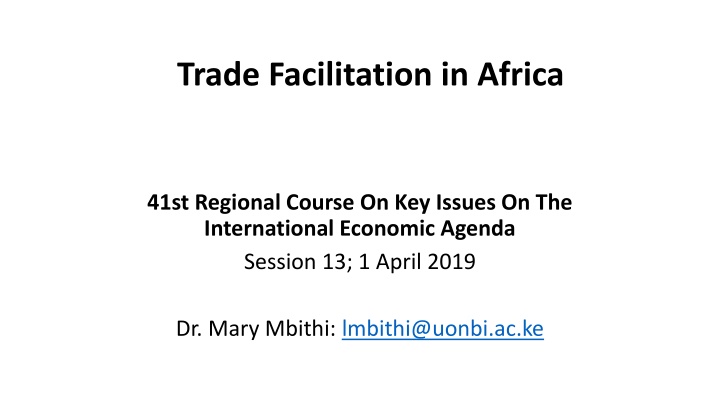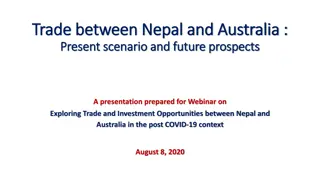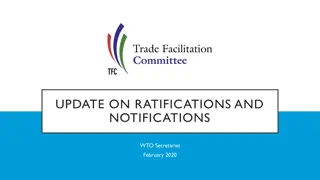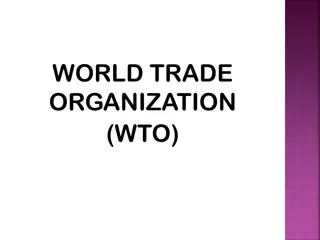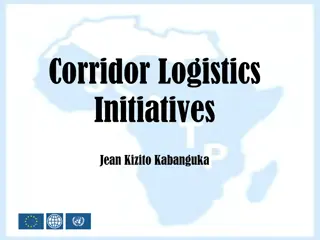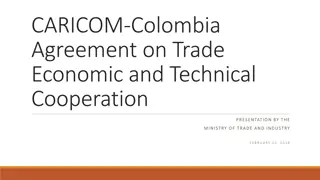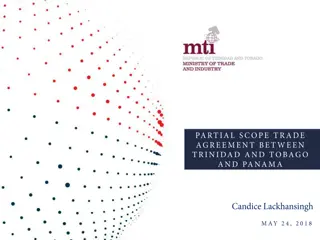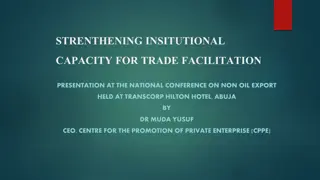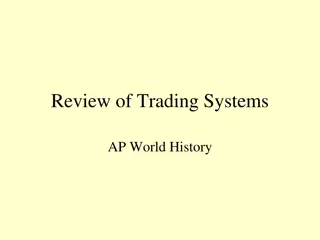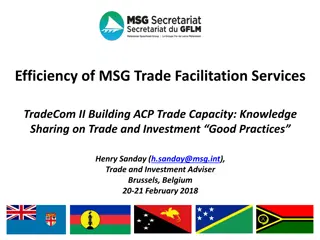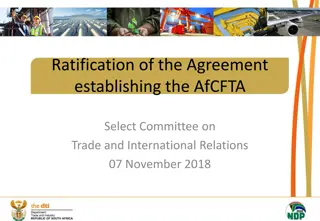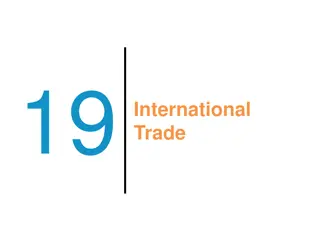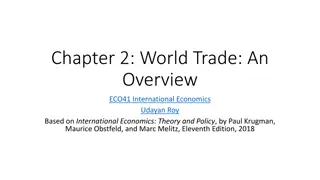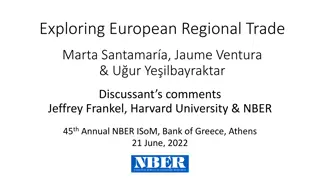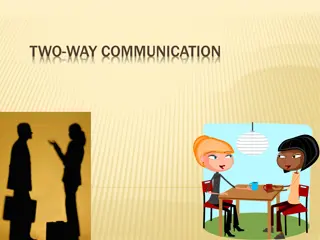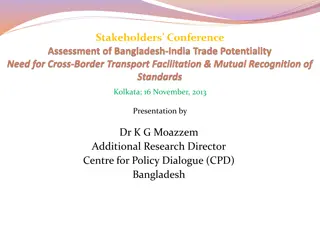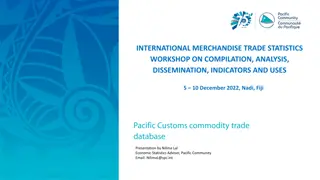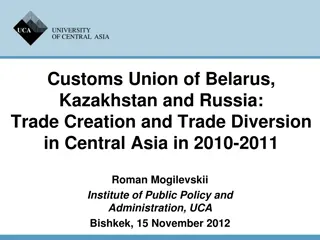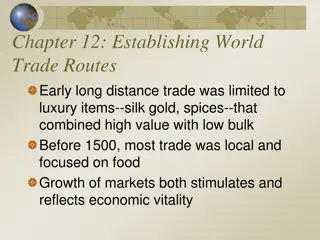Trade Facilitation in Africa
"Explore trade facilitation challenges and opportunities in Africa as discussed during the 41st Regional Course. Dr. Mary Mbithi shared insights on this crucial topic, highlighting strategies for enhancing economic growth in the region through effective trade policies and practices."
Download Presentation

Please find below an Image/Link to download the presentation.
The content on the website is provided AS IS for your information and personal use only. It may not be sold, licensed, or shared on other websites without obtaining consent from the author.If you encounter any issues during the download, it is possible that the publisher has removed the file from their server.
You are allowed to download the files provided on this website for personal or commercial use, subject to the condition that they are used lawfully. All files are the property of their respective owners.
The content on the website is provided AS IS for your information and personal use only. It may not be sold, licensed, or shared on other websites without obtaining consent from the author.
E N D
Presentation Transcript
Trade Facilitation in Africa 41st Regional Course On Key Issues On The International Economic Agenda Session 13; 1 April 2019 Dr. Mary Mbithi: lmbithi@uonbi.ac.ke
Overview and objective Discuss - Regional experiences and transport facilitation in Africa -Kenya s TF and paperless trade -Some specific indicators (relevant to participating countries)
Introduction Trade facilitation and transport facilitation OECD - Specific set of measures that streamline and simplify the technical and legal procedures for products entering or leaving a country to be traded internationally WTO - the simplification and harmonization of international trade procedures with trade procedures being the activities, practices and formalities involved in collecting, presenting, communications and processing data required for the movements of goods in international trade . EU - Trade Facilitation refers to the simplification, harmonisation and automation of international trade procedures, particularly import and export procedures, transit requirements and procedures applied by Customs and other agencies Objectives - Increased speed and efficiency (timeliness and transaction costs) in international trade
Introduction Transport facilitation (UNECE) - A part of trade facilitation the simplification and harmonization of international transport procedures and the information flows associated with them. Objective - To increase efficiency by performing complex operations as rationally as possible while keeping a delicate balance between the requirements of the transport industry and the national economy, on the one hand, and the necessity to conform with indispensable governmental regulations relating to national health and security, customs duties and taxes. Why Transport facilitation matters - Transport costs are a part of trade costs- derive competitiveness and trade outcomes - Transportation costs are estimated to be typically higher than tariffs Direct -Freight costs (direct & insurance) Indirect ( transit & pre-shipment costs) Time related costs- delays lead to higher costs (buffer stocks); loss of business
Why transport facilitation matters for Africa Transport in Africa is often unpredictable and unreliable, and the cost of transport is therefore often higher than the value of the goods being transported (World Bank, 2007). In some areas of Africa, transport costs may constitute a higher trade barrier than import tariffs or other trade restrictions (Amjadi and Yeats, 1995). A one-day reduction in inland travel times could lead to a 7% increase in exports equivalent to a cut of 1.5 percentage points on all importing-country tariffs (Freund and Rocha, 2010). It has also been estimated that a 10% drop in transport costs could increase trade by 25% (Limao and Venables, 2001). )ne study estimating that the unit costs of road transport are 40 100% higher in Africa than in Southeast Asia (Rizet and Gwet, 1998). In landlocked countries, estimates suggest the costs are three to four times higher than in other developed countries (MacKellar et al., 2002). Atkin and Donaldson (2015) reckon that the cost of transporting goods could be up to five times higher (per unit distance) in some sub-Saharan African countries than in the US. In the case of Ethiopia, the cost of distance is estimated to be about 3.5 times higher relative to the US, while in Nigeria, it is 5.3 times higher There is little doubt that such relatively high costs would put upward pressure on the prices of a country s imports, and simultaneously make its exports less competitive in international markets and that both of these factors would act to reduce the country s level of international trade. But why are transport costs high in Africa?
- What leads to higher cost of transport in Africa? Poor quality roads, logistics and trucks, long ques at border crossing (World Bank, 2017) - Has an impact of consumers, especially in remote areas, contributing to increased inequality
Some indicators related to trade and transport facilitation (LPI, world Bank 2018), Rank/160 International shipments Logistics quality and competence Tracking and tracing Country Kenya overall LPI rankCustoms Infrastructure Timeliness 68 67 79 99 64 56 79 Burkina Faso Cameroon Mali Malawi Uganda Comoros Zambia Congo, Rep. Algeria Togo DRC Chad Madagascar E Guinea Lesotho Zimbabwe Niger Burundi 91 95 96 97 102 107 111 115 117 118 120 123 128 136 139 152 157 158 100 90 133 94 76 72 129 123 138 119 108 134 118 151 110 146 157 159 95 76 109 126 124 113 108 138 96 116 132 104 128 151 145 154 142 146 60 63 88 105 78 116 54 64 122 111 127 125 146 62 140 156 158 139 106 87 107 82 99 138 103 127 113 134 100 86 118 133 154 147 150 117 124 118 54 94 123 68 158 125 103 120 114 127 102 149 129 137 141 156 95 142 119 102 110 120 94 103 124 112 133 138 128 126 132 152 155 158
Time to export and costs Time to export: Border compliance (hrs) Cost to export: Border compliance (USD) Time to export: Documentary compliance (hrs) Cost to export: Documentary compliance (USD) Trading across Borders rank/190 Economy Lesotho 38 4 150 1 90 Mozambique Mali Kenya Comoros Uganda Niger Malawi Togo Namibia 91 92 112 118 119 124 126 129 136 66 48 16 51 59 48 78 67 120 602 242 143 651 209 391 243 163 745 36 48 19 50 24 51 75 11 90 160 33 191 124 102 39 342 25 348 Madagascar Zambia Zimbabwe Burundi Chad 138 153 157 169 172 70 120 88 59 106 868 370 285 109 319 49 96 99 120 87 117 200 170 150 188 Eq. Guinea 175 132 760 154 85 Congo, Rep. Cameroon 184 186 276 202 1975 983 120 66 165 306 DRC 188 296 2223 192 500
Time and cost to import Time to import: Border compliance (hrs) Cost to import: Border compliance (USD) Time to import: Documentary compliance (hrs) Cost to import: Documentary compliance (USD) Trading across Borders rank/190 Economy Lesotho Mozambique Mali Kenya Comoros Uganda Niger 38 91 92 112 118 119 124 5 9 150 399 545 833 765 447 1 90 60 90 115 93 296 16 77 60 26 96 98 180 70 145 78 55 168 462 143 612 145 595 380 562 444 669 985 1581 1407 3039 156 55 180 282 162 252 63 150 175 150 1025 500 70 310 849 765 Malawi Togo Namibia Madagascar Zambia Zimbabwe Burundi Chad Eq. Guinea Congo, Rep. Cameroon DRC 126 129 136 138 153 157 169 172 175 184 186 188 6 3 99 120 228 154 242 240 397 271 336 58 72 81 180 172 240 208 163 174
Africa Status of infrastructure: -Limited use of railways
Transport facilitation in Africa Transport facilitation has been at the Centre of Africa integration Abuja treaty establishing the African Economic community (OAU 1991) Article 38: Re-export of Goods and Intra-Community Transit Facilities .freedom of transit through their territories to goods proceeding to or coming from another Member State in accordance with the Protocol concerning Intra-Community Transit and Transit Facilities and in accordance with the provisions of any Intra-Community Agreements to be concluded. Art 39: Customs co-operation and administration - Take all necessary measures for harmonizing and standardizing their customs regulations and procedures to facilitate movement of goods and services across frontiers Art 40: Trade documents and procedures - Member States shall simplify and harmonize their trade documents and procedures
Transport facilitation at continental level To achieve a harmonious and integrated development of the continental transport and communications network Promote the integration of transport and communications infrastructure Coordinate various modes of transport to achieve efficiency Harmonize progressively their rules and regulations relating to transport and communications Draw up co-ordinated programmes to restructure the road transport sector for purposes of establishing inter-State links and the construction of major transcontinental trunk roads Prepare plans to improve, re-organize and standardize the various rail networks of Member States with a view to their inter-connection and construct new railways as part of a Pan-African network Harmonize: policies on maritime, inter-State lake and river transport; air transport policies; programmes on the training in various cadres in transport and communications Modernize and standardize their transport and communications equipment Promote proper integration of air transport in Africa and coordinate flight schedules Coordinate and harmonize their transport policies at regional and Community Integrated High Speed Train Network and Single Air-Transport Network are among the 12 AU Flagship Projects/Initiatives in the agenda 2063
Transport facilitation in Africa Regional initiatives in corridor development The 8 building blocks for economic integration in Africa: Arab Maghreb Union (AMU/UMA)- North The Economic Community of West African States (ECOWAS)- West The East African Community (EAC) External- East The Intergovernmental Authority on Development (IGAD)- East The Southern African Development Community (SADC)- South The Common Market for Eastern and Southern Africa (COMESA)- Southeast The Economic Community of Central African States (ECCAS) Central The Community of Sahel-Saharan States (CENSAD)- North
Transport infrastructure in Africa: African Highways and corridors
Trade, transport and transit facilitation in the corridors .1 Coordinated Border Management A coordinated approach by border control agencies, both domestic and international, in the context of seeking greater efficiencies over managing trade and travel flows, while maintaining a balance with compliance requirements One Stop Border Posts or Joint Border Posts -legal and institutional framework, facilities, and associated procedures that enable goods, people, and vehicles to stop in a single facility in which they undergo necessary controls following applicable regional and national laws to exit one state and enter the adjoining state. They reduce delays at land borders, and the costs related to the delays. Over 80 OSBPs have been planned and/or implemented in various parts of Africa although not al constructed are fully functional! Why?
Trade, transport and transit facilitation2 Use of a regional single customs Administrative document Regional Bond Guarantees Schemes Port Community Systems An electronic communication platform that connects the multiple systems operated by a variety of organisations that make up a seaport or airport community. It is shared in the sense that it is set up, organised and used by firms in the same sector in this case, a port community e.g. Single Window. Improve the systems in terms of punctuality, reliability or costs Single Windows A facility that allows parties involved in trade and transport to lodge standardized information and documents (customs declarations; applications for import and export permits; certificates of origin; and trading invoices) with a single entry point (online portal/window) to fulfill all import, export, and transit-related regulatory requirements." If information is electronic, then individual data elements should only be submitted once .
Transport facilitation in Africa transport corridors Economic factors of some selected corridors (2016)
Use of trade and transport facilitation instruments along the corridors (2016)
Regional experience: COMESA.1 Article 4 (2b) Transport and Communications MS Undertake to make regulations for facilitating trade within the Common Market Article 85 Roads and Road Transport (h) establish common measures for the facilitation of road transit traffic COMESA Protocol on Transit Trade and Transit Facilities is Annex 1 of the COMESA Treaty (1991)
COMESA Transit Transport Facilitation Instruments.2 1. Harmonized road transit charges - Introduced in 1991 (being implemented: Burundi, Ethiopia, Kenya, Malawi, Rwanda, Sudan, Uganda, Zambia and Zimbabwe) - heavy goods trucks with more than 3 axles should pay a road charge of US $10 per 100 km; trucks with up to 3 axles should pay a charge of US $6 per 100 km; and buses with a capacity of more than 25 passengers pay US $5 per 100 km. 2. Harmonized axle loading and maximum vehicle dimensions single steering axle = 8 tons single load or drive axle = 10 tons tandem axle group = 16 tons triple axel group = 24 tons The maximum load limit is 56 tons The maximum vehicle dimensions approved by the COMESA Authority (and currently implemented by Malawi, Eswatini, Zambia and Zimbabwe) are: 5m for a rigid chassis single vehicle or trailer; 17m for articulated vehicles; 22m for truck and draw-bar trailer; 65 maximum width; and 60 maximum height
COMESA Transit Transport Facilitation Instruments.2 COMESA Transit Transport Facilitation Instruments .2 3. COMESA Carrier License Allows commercial goods vehicles to be licensed, with one license, valid throughout the region so that the vehicles can operate in all Member States. This means that vehicles can pick up back- loads in other countries which make more efficient use of the region s transport fleet so reduces the cost of trade. Operation in 11 mainland countries (Burundi, Ethiopia, Eritrea, Kenya, Malawi, Rwanda, Eswatini, Tanzania, Uganda, Zambia and Zimbabwe). 4. COMESA Transit Plate A Plate bearing the letters "COMESA-TRANSIT is to be affix in front and in the rear 5. Yellow Card Third-Party motor vehicle insurance scheme providing third party legal liability cover and compensation for medical expenses resulting from road traffic accidents caused by visiting motorists. Yellow Card issued in one COMESA Member State is valid in all other countries participating in the scheme. Being implemented by 11 countries: Burundi, DRC, Ethiopia, Kenya, Malawi, Rwanda, Eswatini, Somalia, Tanzania, Uganda, Zambia and Zimbabwe.
COMESA Transit Transport Facilitation Instruments.3 COMESA Transit Transport Facilitation Instruments .3 7. COMESA Customs Document - COMESA Customs Document (COMESA CD) 6. Regional customs transit guarantee scheme rctg-carnet - A Customs transit regime to facilitate movement of transit goods under Customs seals in the COMESA region. Ratified by twelve COMESA Member and non-Member States, namely: Burundi, Djibouti, DR Congo, Ethiopia, Madagascar, Malawi, Kenya, Rwanda, Sudan, Tanzania, Uganda and Zimbabwe. - Objective: to ensure that respective governments can recover duties and taxes from the guarantors should the goods in transit be illegally disposed of for home consumption in the country of transit. - Addresses difficulties experienced by transport operators, freight forwarders and clearing agents and at the same time to offer Customs Administrations a secure regional system of control replacing the nationally executed practices and procedures. This also helps to protect the revenue of each State through which goods are carried. - 0.5% of the goods value - RCTG Carnet reduces the cost of transport and clearance by between 10 and 15 per cent
COMESA transit facilitation instruments 8. One Stop Border Posts - One stop border posts (osbp) - reduce the processing time at the border and hence reduce cross-border transactions and enhance competitiveness. A common control zone created for border agencies to share facilities with the aim of eliminating duplication of procedures. 9. COMESA Virtual Trade Facilitation System An electronic initiative to monitor consignments along different transport corridors across the region. It integrates other COMESA instruments on one online platform including: The Yellow Card; RCTG); Transit Data Transfer Module; Carrier License; Harmonized Axle Load andG ross Vehicle Mass Limits; and the Customs Declaration Document. Vehicle use gazetted transit goods routes which have been geo-fenced and must display COMESA- Transit plates Uses software devise (GPS & GSM) that interpret all (container details) the information on the seal and transmits it to dashboard on a centralized server for monitoring from anywhere. The system is accessible to Customs authorities, freight forwarders, insurance companies, banks, port authorities, container freight stations. Provides effective solution for cargo tracking management. In use in the Northern Corridor States of Kenya, Uganda, Rwanda and D R Congo; and in Ethiopia, Djibouti, Malawi, Zambia and Tanzania.
Kenyas TF and paperless trade Kenya Single Window System Single Window System is an online cargo clearance platform launched in Nairobi in May 2014. Implemented and managed by a state agency- Kenya Trade Network Agency (KenTrade) Brings together 42 stakeholders with over 10,000 registered users -Over 35 Government Agencies (PGAs) who issue permits/licenses/certificates related to export and import processes Cargo clearance documentation has been automated through System integrations or interfaces with Kenya TradeNet System. Also linked to the financial institutions (banks, mobile payment solutions) through Kenya Revenue Authority (KRA) iTax System and the Governments eCitizen platforms and therefore providing an end to end electronic cargo documentation platform. KenTrade in 2016 implemented Information for Trade in Kenya Portal (InfoTradeKenya), a web-based platform used by the Government to publish trade regulatory information To enhance access to information and understanding of the required regulatory procedures to import and export Live on-line platform portal www.infotradekenya.go.ke enables traders to access step by step guide on import/export requirements InfoTradeKenya is part of the Government s initiative to facilitate trade in line with the World Trade Organization (WTO) Trade Facilitation Agreement (WTO-TFA article 1.2 that obliges governments to be transparent and to provide information to businesses in the internet.
Achievements Achievements Reduction in the average number of processes involved in processing clients applications by almost 50%; Reduction in the average number of documents required by about 30 50%; Paperless (electronic) application by traders 24/7 basis; Reduction in use of paper resulting to cost savings; Time taken to process clients requests has reduced by over 50%; Electronic processing and confirmation of Payments; Provision of multiple payments channels; Significant time savings in preparation of manifest from 2-3 days to just 15 mins for client with own automated systems; Establishment of single point of contact for the business sector to interact with government on issues related to import/export documentation Removal of potential to falsify documents leading to Government Agencies confidence in documents processed via the System- further speeding up processing. Increased Compliance Increase revenue collection by a number of PGAs
Achievement: Cost saving Average Explicit Cost Savings Demurrage charges (KES) 168,636/- 119,864/= 48,773/ (about US$ 500) Warehousing charges (KES) 760,167/- 726.083/= 34,083/ (about US$ 300) Stationary (KES) 37,957/- 18,732/= 19,225/ (abour US$ 200) Payment to the messenger 39,539/- 14,492/ = 26,049/ (about US$ 100) Payment to the clerk (KES) 17,500/- 8,250/= 9,250/ (about US$ 100) Printing (KES) 40,526/- 13,998/= 26,529/ (about US$ 300 ) Photocopying (KES) 33,438/- 10,422/= 23,016/ (about US$ 300) Source ( KENTRADE, 2016)
..but some Challenges Inadequate legal framework - The National Electronic Single Window System Draft Bill, 2016 Conflicting mandates by some Government Agencies Recurrent budgetary Constraints Limited ICT skills and infrastructure to assure acceptable system availability. ICT Security issues (Due to centralized information sharing and electronic documents). Slow resolution of issues - limited workarounds in automated environment
What are the challenges with transport transportation in your country?
References African Centre for Economic Transformation (2016). Trade fqacilitation and economic transformation in Africa. https://set.odi.org/wp-content/uploads/2016/03/SET-ACET-ATF-Trade- Facilitation-Paper.pdf Report on the Corridor Assessment and Ranking for Selecting at Least One Pilot Smart Corridor. https://www.tralac.org/images/News/Documents/Report%20on%20the%20Corridor%20Assessme nt%20and%20Ranking%20for%20Selecting%20at%20Least%20One%20Pilot%20Smart%20Corridor %20May%202016.pdf TRANS-AFRICAN HIGHWAYS NETWORK ROUTES. https://au.int/web/sites/default/files/newsevents/workingdocuments/29736-wd-e_- _tah_annex_i_tah_network.pdf Tralac (2017). One-Stop Border Post (OSBP) Sourcebook, 2nd edition https://www.tralac.org/news/article/11453-one-stop-border-post-osbp-sourcebook-2nd- edition.html
Trade Facilitation in Africa ..Asante Sana Dr. Mary Mbithi; lmbithi@uonbi.ac.ke
